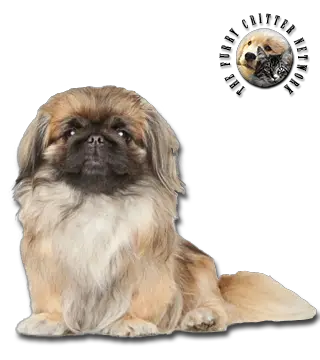Breed Standard
Head: Massive, wider than it is tall, flat. Wide, flat skull. Pronounced stop. Short, wide nose. Tight-lipped.
Ears: Heart-shaped, carried flat against the head. Long, abundant feathering.
Eyes: Large, round, dark. Edges of eyelids are black.
Body: Wide forequarters, narrower near the abdomen, short. Thick, very short neck. Wide chest. Well-sprung ribs. Pronounced flank. Straight back.
Tail: Set on high, carried firmly, curved loosely on one side of the back. Long feathering.
Hair: Long, straight, with an abundant mane forming a collarette around the neck. Long, abundant hair on the ears, backs of the legs, tail, and feet. Dense undercoat.
Coat: All colors and markings are allowed and equal in value, except albino and brown (liver). In the multi-color variety, markings are evenly distributed.
Size: 15 to 25 cm.
Weight: 2.5 to 5.5 kg.
History
This dog of Chinese origin is one of the world’s oldest breeds. He is depicted on bronze objects over 4,000 years old. For centuries, the Pekingese was bred, maintained, and honored in China’s Imperial palace. Believed to protect the emperor in the afterlife, the Pekingese was sacrificed at the emperor’s death. After seizing Peking and pillaging the Summer Palace in 1860, British soldiers brought Pekingese dogs back to England. There, they were given to Queen Victoria, the Duchess of Wellington, and the Duchess of Richmond, who established the first strain of "sun dog" from Imperial China. The Pekingese became very popular between World Wars I and II. Although limited, the breed's population remains stable.
Behavior
This lively, independent, strong-willed dog is very attached to his owner and does not always tolerate children. Distant toward strangers, the Pekingese barks often and is a good watchdog. He needs firm but gentle training.
Keeping the Pekingese coat healthy and presentable requires daily brushing, and a trip to the groomer every 8–12 weeks. One important thing for new owners to remember is that dogs intended as a house pet may be kept in a puppy cut which requires less maintenance than a show cut. It is also important to remove foreign materials from the eyes daily, and the creases on the face to prevent sores (hot spots). It is also necessary to keep and maintain the fur in the buttocks of the Pekingese clean and well groomed as the area is prone to soiling.
Due to their abundance of fur, it is important to keep the Pekingese cool. The breed is prone to have heatstroke when exposed to high temperature for a long time.
Pekingese exercise needs are minimal. Due to their extremely short snouts, they tend to have a high risk for breathing difficulties (most notably Brachycephalic obstructed airway syndrome). Because of this, they are incapable of more than around 30 minutes of exercise per day. It is important to monitor their breathing while exercising, especially if they are in the heat. If the Pekingese begins wheezing, exercise should cease immediately. After running, they should spend time resting in a cool place until their breathing returns to normal. They should also have access to plenty of water before, during, and after exercise to prevent overheating and dehydration.
He is happy living in an apartment. Not highly athletic, he needs only short daily walks. He requires daily brushing and combing, and his eyes and the folds on his face must be checked regularly.
Function
Pet.
Health
The leading cause of death for Pekingese, as for many other Toy breeds, is trauma. Primary health concerns include neurologic and cardiovascular defects, e.g., congestive heart failure. When diagnosed early and successfully treated with medication, a Pekingese with this condition can live many years. A heart murmur is a potential indicator, and must be evaluated by a veterinary cardiologist. Often the murmur does not surface until the dog is six years old, so it is difficult to screen in a puppy.
As a result of breeding for an increasingly flattened face, its brachycephaly can lead to health issues in some Pekingese. Therefore other potential concerns in the breed are eye issues and breathing problems, resulting from its tiny skull and flattened face. Furthermore skin allergies (and hotspots) and eye ulcers may develop spontaneously. Pekingese may also develop keratoconjunctivitis sicca (dry eye) progressive retinal atrophy, along with glaucoma, in which buildup of ocular fluid places pressure on the eye, resulting in drainage. Improper development of the eye's filtration angles is the leading cause.
The Pekingese must be kept indoors, as their flattened faces and nasal structure can cause them to develop breathing problems, making it difficult for them to regulate their body temperature in hot weather. Their long spines, relative to their legs, make them vulnerable to back injuries. Care should be taken when picking them up to give adequate support to the back: one hand under the chest, the other under the abdomen. As an achondroplasiac breed, some Pekingese find stairs difficult, and older dogs may not be able to go up or down stairs alone. To avoid injury, they should also be discouraged or prevented from leaping from furniture and other heights; pet stairs may be useful to access beds.
In an effort to address potential breathing difficulties caused by the breed's flat face, the Kennel Club (UK) significantly changed the breed standard in October 2008, removing the clause that the "profile (should be) flat with nose well up between eyes" and adding instead that the "muzzle must be evident". This was in response to public opinion following the BBC programme, Pedigree Dogs Exposed. The breed standards of two other brachycephalic breeds, the Pug and English Bulldog, were soon also changed.






